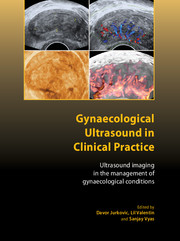 Gynaecological Ultrasound in Clinical Practice
Gynaecological Ultrasound in Clinical Practice Book contents
- Frontmatter
- Contents
- About the authors
- Abbreviations
- Preface
- 1 Ultrasound imaging in gynaecological practice
- 2 Normal pelvic anatomy
- 3 The uterus
- 4 Postmenopausal bleeding: presentation and investigation
- 5 HRT, contraceptives and other drugs affecting the endometrium
- 6 Diagnosis and management of adnexal masses
- 7 Ultrasound assessment of women with pelvic pain
- 8 Ultrasound of non-gynaecological pelvic lesions
- 9 Ultrasound imaging in reproductive medicine
- 10 Ultrasound imaging of the lower urinary tract and uterovaginal prolapse
- 11 Ultrasound and diagnosis of obstetric anal sphincter injuries
- 12 Organisation of the early pregnancy unit
- 13 Sonoembryology: ultrasound examination of early pregnancy
- 14 Diagnosis and management of miscarriage
- 15 Tubal ectopic pregnancy
- 16 Non-tubal ectopic pregnancies
- 17 Ovarian cysts in pregnancy
- Index
10 - Ultrasound imaging of the lower urinary tract and uterovaginal prolapse
Published online by Cambridge University Press: 05 February 2014
- Frontmatter
- Contents
- About the authors
- Abbreviations
- Preface
- 1 Ultrasound imaging in gynaecological practice
- 2 Normal pelvic anatomy
- 3 The uterus
- 4 Postmenopausal bleeding: presentation and investigation
- 5 HRT, contraceptives and other drugs affecting the endometrium
- 6 Diagnosis and management of adnexal masses
- 7 Ultrasound assessment of women with pelvic pain
- 8 Ultrasound of non-gynaecological pelvic lesions
- 9 Ultrasound imaging in reproductive medicine
- 10 Ultrasound imaging of the lower urinary tract and uterovaginal prolapse
- 11 Ultrasound and diagnosis of obstetric anal sphincter injuries
- 12 Organisation of the early pregnancy unit
- 13 Sonoembryology: ultrasound examination of early pregnancy
- 14 Diagnosis and management of miscarriage
- 15 Tubal ectopic pregnancy
- 16 Non-tubal ectopic pregnancies
- 17 Ovarian cysts in pregnancy
- Index
Summary
Introduction
For many years, urogynaecologists and urologists have relied on cystometry and urethral function tests to evaluate the female lower urinary tract. However, with the improvements in ultrasound imaging techniques, this diagnostic modality has been increasingly used for the assessment of lower urinary tract dysfunction and pelvic floor disorders. Ultrasound has the advantage of being able to visualise fluid-filled structures without the need for contrast medium. It can also demonstrate soft tissue structures such as the kidney, bladder wall, urethral and anal sphincters and surrounding pelvic floor musculature. It also avoids ionising radiation and can be used safely and repeatedly in women of reproductive age. Most ultrasound equipment is transportable and readily available within a gynaecological department. Operating costs of ultrasound are low and the technique should be readily available in most urogynaecological units.
Ultrasound of the lower urinary tract and pelvis
The bony enclosure of the pelvis around the empty bladder and urethra limits the views obtained by ultrasound imaging. Use of the transabdominal, transvaginal, transrectal and transperineal approaches for ultrasound scanning allows for easy visualisation of different aspects of the lower urinary tract. Perineal and transabdominal probes are usually linear array transducers, while transvaginal and transrectal probes are either linear array or sector scanners. Linear array scanners have the disadvantage of being bulky and having low operating frequencies, whereas sector scanners are smaller, more expensive and operate at a higher frequency producing better image resolution. Higher ultrasound frequency provides better image resolution at the expense of decreased depth of penetration owing to increased attenuation.
Keywords
- Type
- Chapter
- Information
- Gynaecological Ultrasound in Clinical PracticeUltrasound Imaging in the Management of Gynaecological Conditions, pp. 107 - 120Publisher: Cambridge University PressPrint publication year: 2009


